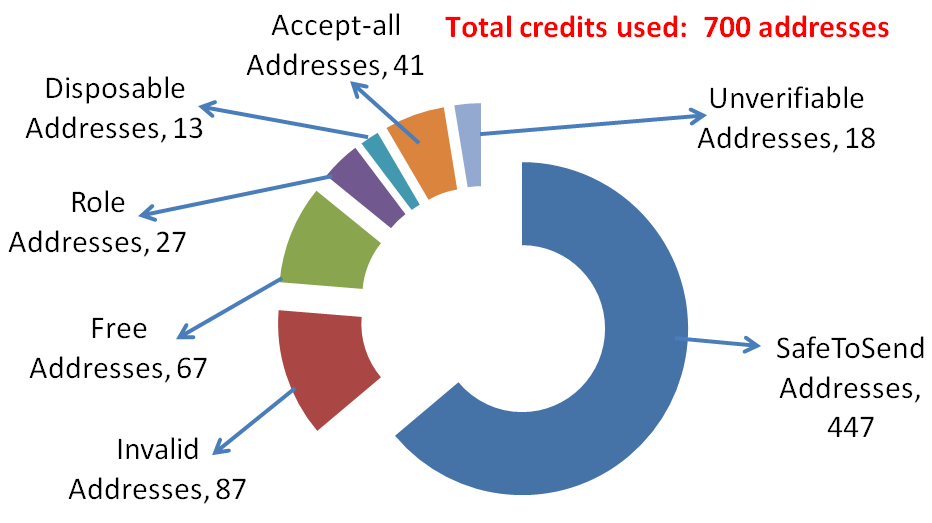Everything You Need to Know About Email Verification
Email marketing has grown to become powerful and productive due to several reasons. Two reasons, however, stand out: email marketing is easy to use and email marketing produces results.
For the uninitiated, email marketing has an RoI of 4400%. Put differently, it means email marketing generates $44 of revenue for every $1 spent.
But these very benefits – convenience and results – have also thrown up some stiff challenges for the sincere marketer. Only marketers who keep themselves updated with the changing scenario can manage to get great returns from their email marketing efforts.
One of the challenges is battling incorrect or invalid email addresses. Hundreds of thousands of emails bounce back to the sender every day, undelivered. That means tons of lost opportunities and huge amount of money wasted sending emails to addresses that didn’t exist in the first place.
The clearest solution to this problem is email address verification, more commonly known as email verification.
What is email verification
Email verification is the process of verifying the validity and accuracy of an email address without actually sending an email address.
Specialized software running on detailed algorithms go through a number of steps to verify if the email address is correct. Starting from the basic checks, the software keeps applying subsequent tests, based on the result of each of the previous check.
At the end of the process, the system produces and displays the result. This result helps the sender make an informed decision on whether to retain the email address in her mailing list, segment it under a different title or entirely dispose the email address.
How email verification is carried out
There are a large number of email verification services available out there. While they could have been coded to run the tests differently, the underlying principle remains identical. The explanation of the email verification process given below has been simplified; the actual process is more complicated (and extremely swift).
Normally the process is carried out in the following sequence:
1. Syntax checking: No matter what, all email addresses have an identical syntax: local-part, followed by the “@” symbol, followed by the domain name and finally the extension (dot com, dot edu and so on), all without any blank spaces. The first test of an email address is whether it follows the syntax. If not, the email address is rejected as incorrect.
2. Domain and MX record checking: If the email address has the correct syntax, the system checks whether the domain name and MX (mail exchange) record exist and are correct. The MX record specifies the mail server responsible for receiving the email message.
3. Role address detection: Email verification tools don’t stop at telling you if the email address is valid or not. They try and tell you what kind of email address it is. During this test, the system verifies if the email address refers to a person, e.g. sandy(at)domain(dot)com or whether it is a role address, e.g. sales(at)domain(dot)com. We’ll soon explain why this matters.
4. Disposable email address detection: The next stage is to detect and report if the address is a use-and-throw disposable email address. For instance, a service called Mailinator offers disposable addresses. Such email addresses are extremely short-lived and provide no engagement, so the email verification service wants to figure this one out too.
5. Accept-all detection: Some mailboxes are configured in a way so that no matter what name you write in the localpart, the mailbox will accept it. Hence, you(at)domain(dot)com, sandy(at)domain(dot)com, xn2kwe9(at)omain(dot)com, all emails will be accepted. The email checker will try and find if the address is an accept-all. We’ll explain why this matters too.
6. Free email service detection: Services like Gmail, Yahoo, Hotmail, AOL are basically free services. The email checker tool ascertains if the address belongs to such a service.
The email verification service will also conduct a deeper SMTP verification to verify the existence of the mailbox.
How you can use email verification
Using the services of an email verification company isn’t the only way to verify an email address. There are other ways too; using PHP code for instance. However, the email verification conducted by specialized companies is superior and more comprehensive than any other method.
As mentioned earlier, there are several email verification companies out there: you can find some of the top ones listed on this blog. Or you can simply google for ‘email verification services’. Almost all of them offer a free trial; some even offer upto 100 credits free per day.
There are three ways you can use their services:
1. Bulk verification: You can upload your entire mailing list onto the system of the email verification company you choose. Bulk verification is fast – about an hour and a half is all it takes to verify 100,000 email addresses.
2. Real-time verification: With an email verification API, you can verify email address in real-time, just as subscribers enter them through sign-up forms, inquiry forms and so on. Typically takes 1 or 2 seconds per address. It helps avoid typos and spot fake addresses that have been intentionally entered.
3. Integration with ESPs: If you’re using an Email Service Providers (ESPs) i.e. an email marketing company (like Drip, Emma or ConstantContact, for instance), you can use their integrations with the email verification service to directly verify your mailing list from there.
Why email verification is important
The benefits of email verification have been explained very well in an earlier post on TechnoWorldNews.
However, this is a good place to understand why identifying Accept-all, Disposable and Role-addresses is important. While Accept-all and Role-addresses are relatively permanent, there won’t be necessarily one person operating that address. Hence the engagement metrics are skewed and erratic. Decisions based on these metrics turn out pretty much meaningless.
Further, Accept-all addresses are often spam traps. Spam traps are email addresses that are maintained specially to identify spammers. If you keep sending emails to such addresses, the entire email ecosystem could label you as a spammer or you could be penalized. In the worst case scenario, your service provider could even refuse to carry your emails.
Disposable addresses are mostly used to access more content, like downloading a pdf or watching a video. People using such addresses have almost no interest in staying connecting with you. All your efforts into crafting a great newsletter go down the drain. No point having them on your mailing list.
Best marketing practices recommend you remove Accept-all, Disposable and Role-addresses from your mailing lists. With stringent regulations like the GDPR already in place, you’ve got to make sure you play it very safe.
What would typical email verification results look like
Again, different email verification service providers could present their verification results differently. One of the most common formats is given below:
The above result shows the break-up of the various types of email addresses after verification.
The SafeToSend addresses are the ones that would bring the best results in response to your email marketing campaign. They are the also the ones that would show the best engagement.
Depending upon what product or service you’re trying to promote through your email campaign, your next bet would be the Free Addresses. Traditionally, B2B products don’t perform very well under Free Addresses, since Free Addresses are not official addresses. The same addresses, however, can do better under B2C.
In other words, SafeToSend and Free Addresses are the only two categories you should send your emails to.
Email verification services would provide you various options as to what you’d like to do with the result: you could update the same mailing list, you could create a new mailing list that contains only the SafeToSend and Free Addresses or you could export the results back to your ESP.
All this information may sound a little overwhelming, but it’s not. When you follow best email marketing practices, you get better results from the tremendous efforts you have put in.
- Everything You Need to Know About Email Verification - August 4, 2018






